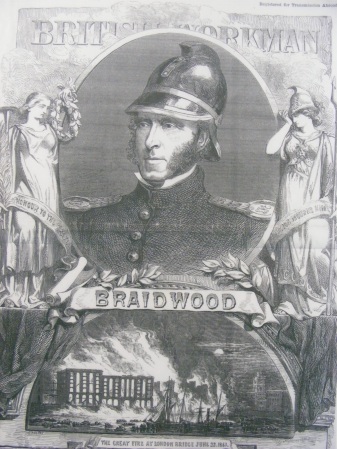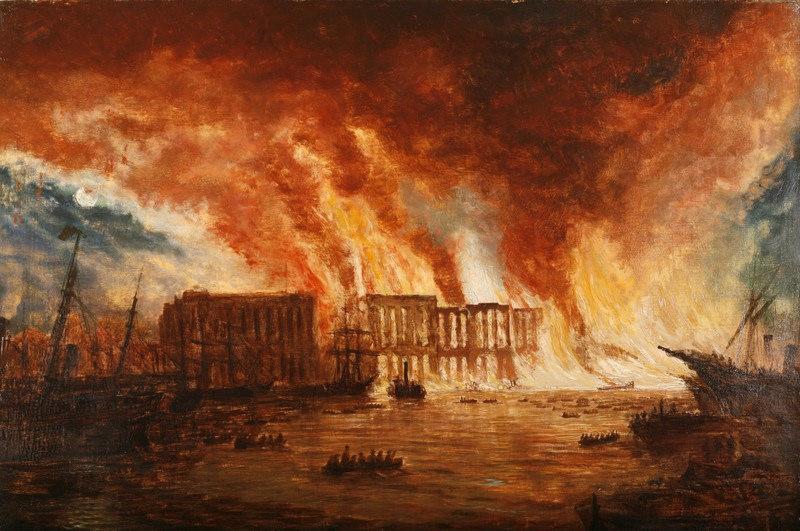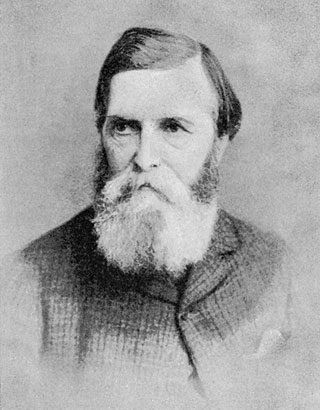The choice: R.M. Ballantyne, Fighting the flames (London, 1867).
Chosen by: Graham Hogg, Curator (19th-Century Printed Collections and Photo-graphs), Rare Books, Maps and Music Collections
Welcome to the latest of our fortnightly series where we introduce you to some favourites from our collections for you to enjoy reading, all freely available online.
Read or download this book for free from Project Gutenberg
About four years ago I was able to purchase from an antiquarian bookseller the first edition of this children’s novel to add to the National Library’s collections. For some reason the Advocates Library had not received a copy of Fighting the Flames at the time through legal deposit. Presumably, since the foundation of the National Library of Scotland in 1925, a suitable copy had not come on the market or no one had spotted the gap in our holdings of a prolific, if now somewhat neglected, Scottish author.
I have to confess that I had not heard of the book before I purchased it. I associated Edinburgh-born author Robert Michael (R.M.) Ballantyne (1825-1894) more with adventure stories in exotic locations. His most famous work, The Coral Island, would prove to be an inspiration for Robert Louis Stevenson’s Treasure Island and would later be brilliantly subverted by William Golding’s Lord of the Flies. A novel about the London fire brigade seems prosaic in comparison with pirates and cannibals on desert islands or fur traders in the icy wastes of Canada. However, this is a rattling good adventure story, written for adults as much as for children. You don’t find yourself wincing while reading it because its London setting means that Ballantyne, a true son of the Empire, does not display his zeal for British supremacy or include heavy religious moralising, both of which are all too apparent to the modern reader in The Coral Island.
One thing that Ballantyne did, which sets him apart from contemporary children’s authors, was carry out detailed research for his novels, and not just from the comfort of his own armchair. He worked in a Cornish tin mine (Deep Down: a Tale of the Cornish Mines), went to the bottom of the Thames in a diving suit (Under the Waves), and for Fighting the Flames worked in a London fire station. He can thus write from a position of authority:
to those who mount an engine for the first time and drive through the crowded thoroughfares of London at a wild tearing gallop, it is probably the most exciting drive conceivable. It beats steeple-chasing. It feels like driving to destruction – so wild and so reckless is it.
He goes on to describe vividly a high-speed dash on a horse-drawn fire engine through the crowded streets of night-time London to put out a fire. The novel very effectively conveys the ever-present danger of fires in a mid-19th-century London made up of rickety old buildings, full of combustible material, and where naked flames from candles, stoves and fireplaces were an everyday cause of disaster.
The events in the novel take place a few years before the book was published, at a time when the then privately-funded London fire service had “reached a high state of efficiency.” This efficiency was largely due to a Scot, James Braidwood, who had moved from Edinburgh in 1833 to take charge of the London Fire Engine Establishment. Braidwood is a minor character in Fighting the Flames, a historical figure transported into the realms of fiction, but Ballantyne proudly includes some factual passages in the novel which describe some of the reforms his fellow Scot had instituted to improve the London fire service.
The entry for Ballantyne in the Oxford Dictionary of National Biography notes that in a work like Fighting the Flames he was able to combine successfully his social conscience and his commercial sense for what would appeal to his readership. Social conscience is represented by the two male protagonists, Frank “Blazes” Willders and his younger brother Willie. They are from a humble background, their widowed mother having been shunned by her wealthy brother-in-law because she had married beneath her station. Despite their lack of money and social status, the Willders are both selflessly devoted to helping those less fortunate themselves. Frank is the strapping young fire fighter who bravely risks his life to save others in raging infernos, Willie is the cheeky cockney urchin with the proverbial heart of gold. Ballantyne creates a series of interesting characters for them to interact with, including the hard-hearted businessman Auberley, the villainous landlord Gorman, the eccentric inventor Tippet, the acerbic, eagle-like Miss Deemas, the family of acrobats the Cattleys, as well as the “roughs” who constitute London’s underclass.
The action moves forward seven years and the novel reaches its climax with a depiction of a real-life event, the calamitous Tooley Street fire of 1861 in the wharves and warehouses near London Bridge. 
The fire, which Ballantyne claims was the greatest seen in London since 1666, has fateful consequences for both Frank Willders and James Braidwood. The author prefaces his account of the desperate efforts to fight the fire with another outpouring of social conscience:
Fire has fought with us and fed upon us since we became a nation, and yet, despite all our efforts, its flames are at this day more furious than ever. There are more fires daily in London now than there ever were before. Has this foe been properly met? … Referring to the beautiful organisation of the present Fire Brigade, the ability of its chiefs and the courage of its men, the answer is, Yes, decidedly. But referring to the strength of the brigade; to the munitions of war in the form of water; to the means of conveyance in the form of mains … the answer to the question, “Has the foe been properly met?” is emphatically, No.
By the time Fighting the Flames was published in 1867 the Metropolitan Fire Brigade Act had been passed, which resulted in the foundation of the publicly-funded London Fire Brigade. Ballantyne clearly derived a great deal of satisfaction in the establishment of the new fire service, even if he did feel it needed more staff and access to better water supplies. He could also feel satisfied at the commercial success of Fighting the Flames, the book was reprinted over 30 times in the following 30 years.
Look out in two weeks for our next Curator’s Favourite, and in the meantime enjoy reading!
Further information
You can read and download more titles by R.M. Ballantyne, such as Hudson Bay, or Everyday life in the wilds of North America in our Antiquarian Books of Scotland resource in the Digital Gallery on our website.
Ballantyne’s home in Harrow, London, from 1879 until shortly before his death, is marked by a blue plaque
A statue of James Braidwood was erected in Parliament Square, off Edinburgh’s Royal Mile, in 2008
Braidwood’s grave can be found in Abney Park cemetery in Stoke Newington, London
